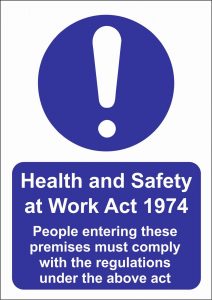 By Shelly Asquith, Health, Safety & Wellbeing Officer in the TUC Organisation, Skills and Services Department.
By Shelly Asquith, Health, Safety & Wellbeing Officer in the TUC Organisation, Skills and Services Department.
50 years ago today, one of the first new laws of a newly elected Labour government was the Health and Safety at Work Act.Half a century on, what is the legacy? And what do we need now as another Labour government takes office?
Ever since the Trades Union Congress was established, in 1868, we have fought to protect workers.
When, just over a century later, we saw health and safety at work regulation enshrined in law, it was a welcome move: A new agency that could prosecute employers who failed to keep work safe represented a serious deterrent, and one we would not have seen were it not for union pressure.
Since then, the number of fatal injuries at work has fallen by over 80 per cent, from 651 deaths in 1974 to 138 this year.
A foundation to build on, one might think. Instead, over time, the main work safety regulators have been systematically de-funded and defanged.
So much so that you are now more likely to win the lottery than have a safety inspector visit your workplace. Fewer inspectors, inspections and actions against employers – especially so during the Covid crisis, that saw thousands of workers die following exposure at work. The austerity-hit HSE has had a 54 per cent cut in funding, and in local authorities the picture is even worse.
In turn, we are seeing a surge in occupational ill-health. While fewer workers die from injuries on the job, many suffer the effects of occupational cancers or work-related stress. In fact, an estimated 50,000 people in Britain lose their life to work causes every year. Despite all the rules and regulations, employers still cut corners, prioritising profit over people’s lives.
All the while, it has remained our unions that we rely on to keep work safe. As our formal protections are undermined and eroded, it’s not the law we turn to, but each other.
When the TUC undertook a study in the Covid pandemic, comparing workplaces with safety reps and those without, we found workplaces with union reps were 20 per cent more likely to have the right PPE, and 40 per cent more likely to have had a risk assessment shared with the workforce.
Trade union health and safety reps are the most effective guard against hazardous work, the only reliable regulation in the workplace. Much of the activities of safety reps goes on in the background, and it cannot be overstated the difference we can make, influencing risk management and representing colleagues.
Sometimes, too, we demonstrate that the right to withdraw our labour is our ultimate leverage, far beyond the words of an Act or the warnings of an unlikely inspection.
In the last year we have seen industrial action get the goods. Where management failed to recognise safety concerns raised by unions, we saw housing workers strike over asbestos exposure, on the railways a strike over long hours causing fatigue, and in one local authority, an indefinite walkout over access to sick pay.
In all these cases, the workers won.
 The 1974 Act was not a magic wand, and the existing legislation does not go far enough. For example, unions are still seeking greater rights for reps, guaranteed access to workplaces where we have members, explicit protection from specific hazards like working in extreme heat, the recognition of work-related suicide.
The 1974 Act was not a magic wand, and the existing legislation does not go far enough. For example, unions are still seeking greater rights for reps, guaranteed access to workplaces where we have members, explicit protection from specific hazards like working in extreme heat, the recognition of work-related suicide.
The list goes on. The TUC will continue to make the case for more resources in workplace health and safety – strong unions, effective regulation, and justice for all those entitled to it.
What’s more, if the Act, in its 50th year, is going to be worth more than the paper it’s written on, then we need a regulator, an enforcer, that functions. We need a properly funded HSE and stronger rights for union safety reps, starting with repealing the anti-strike laws that limit our ability to act in the face of danger.
While governments and Ministers can be reshuffled or unseated overnight, an organised working class is far harder to replace or beat.
Legislation is important, but unions are vital. That’s why, to mark the 50th year of a law designed to improve our safety, we are focusing our efforts on engaging the frontline, not the frontbench: By finding, training and retaining hundreds of new union health and safety reps.
With an ageing profile of existing reps, we are especially looking for young union members to take on the role, so that they might play their part in keeping workers safe for the next 50 years.
